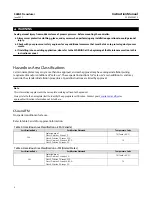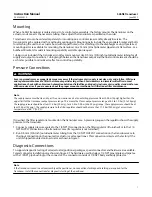
Instruction Manual
D103425X012
546NS Transducer
June 2021
14
Principle of Operation
Refer to the schematic drawing in figure 5. Assume that the transducer is direct‐acting. An increase in the DC signal to
the coils increases the magnetic field around the coils. This field increases the magnetic strength in the armature and
the magnetic attraction across the air gap between the armature and the pole pieces.
The pole pieces are already polarized by the permanent magnet. The armature polarity is as shown in the schematic.
The magnetic attraction will therefore be downward at the nozzle end and upward at the feedback bellows end,
resulting in a torque that rotates the armature about the fixed torsion rod to cover the nozzle.
The resulting restriction produces an increased pressure in the nozzle, in the upper chamber of the relay, and in the
feedback bellows. The relay responds to the increase in nozzle pressure by increasing the output pressure to the
actuator and control valve. The increased pressure in the feedback bellows creates a force that acts on the armature to
move it back to an equilibrium position. In this way, the new nozzle pressure is compared to the input current by the
force‐balance principle.
The relay operates in the following manner. The nozzle pressure acts on the large top diaphragm to force the center
spacer assembly (mounted between the two diaphragms) downward against the valve plug, closing the exhaust port
and opening the supply port. Supply air then flows through the open port to the output load. The output pressure
continues to increase until the relay diaphragm assembly is pushed back to its original position by the force of the
pressure acting on the small diaphragm. When this occurs, the valve plug is closed again.
When a decreasing DC signal is received, the magnetic attraction across the air gap is reduced. The armature rotates
to uncover the nozzle and decrease the pressure in the nozzle, relay, and feedback bellows. The relay diaphragm
assembly moves upward, and the exhaust port opens to bleed the output pressure to atmosphere.
Figure 5. Transducer Schematic
FEEDBACK
BELLOWS
POLE
PIECES
COIL
ARMATURE
TORSION ROD
EXHAUST
OUTPUT
RELAY
VALVE PLUG
SUPPLY
FIXED
RESTRICTION
CENTER SPACER ASSEMBLY
EXHAUST PRESSURE
SUPPLY PRESSURE
NOZZLE PRESSURE
OUTPUT PRESSURE
NOZZLE
ARMATURE
PERMANENT
MAGNET
ZERO ADJUSTMENT
SPAN ADJUSTMENT
(MAGNETIC SHUNT)
CP4285-A
A1505-3










































